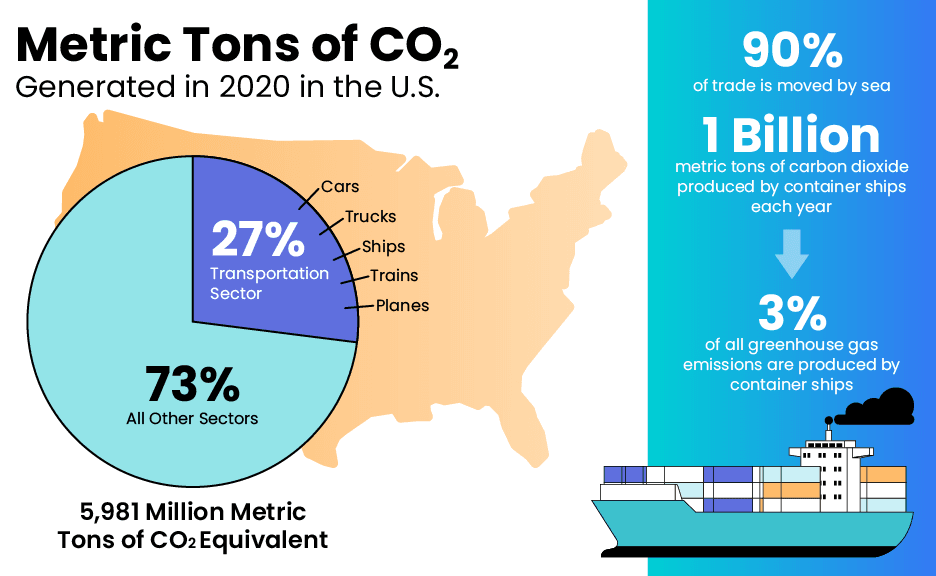Biofouling Management: Achieving Green Shipping with a Clean Hull


Approximately 5,981 Million Metric Tons of CO2 equivalent were generated in 2020 in the United States alone, with the transportation sector producing the largest share at 27 percent, in which the primary source of emissions is the burning of fossil fuel for cars, trucks, ships, trains, and planes.
On a global scale, around 90 percent of trade is moved by sea, with container ships producing over a billion metric tons of carbon dioxide each year. This accounts for around three percent of all greenhouse gas emissions – a percentage that the International Maritime Organization has vowed to decrease with IMO biofouling management guidelines, as well as the introduction of the Energy Efficiency Index for Existing ships (EEXI) and the Carbon Intensity Indicator (CII) rating, regulatory measures that aim to reduce the maritime shipping industry’s greenhouse gas (GHG) emissions by as much as 70 percent by 2050.
This push for green shipping – a term used to describe the efforts to reduce the environmental impact of the shipping industry, including the reduction of greenhouse gas emissions, air pollution, and marine pollution – necessitates an ongoing commitment by shipping sector leaders to adopting practices and methodologies that would contribute to greener, more efficient fleet performance. One such mitigation practice is biofouling management.
What is a Biofouling Management Plan?
What is biofouling, and what does it have to do with green shipping?
Biofouling is the accumulation of marine organisms on surfaces that are in contact with seawater, such as ship hulls, offshore structures, and pipelines.
Ship biofouling specifically refers to the accumulation and colonization of marine organisms, such as algae, barnacles, mussels, and other animals on the submerged surfaces of a ship's hull and other structures that are in contact with seawater. When a ship moves through seawater, it creates a micro-environment that promotes the attachment and growth of these organisms. This creates a biofouled hull, which can have several negative impacts on a vessel’s ability to achieve green shipping, including increased fuel consumption and greenhouse gas emissions, decreased efficiency of equipment, and increased maintenance costs.
A biofouling management plan helps mitigate these negative impacts with the use of various methods to prevent or control the accumulation of marine organisms on surfaces. Biofouling management helps contribute to cleaner hulls, which will improve fleet efficiency and decrease CO2 emissions, ultimately resulting in greener shipping and aiding in CII compliance.
How Biofouling Management Can Accelerate Green Shipping
So how does it actually work in practice? Effective hull biofouling management can help reduce greenhouse gas emissions in the following measurable ways:
Reduced Fuel Consumption Biofouling on ship hulls increases drag, which can result in increased fuel consumption and greenhouse gas emissions. By preventing or reducing biofouling, ships can operate more efficiently and consume less fuel, resulting in lower greenhouse gas emissions.
Reduced Maintenance Biofouling can also increase the frequency and cost of maintenance on equipment, such as heat exchangers and pipelines. By adhering to biofouling management plan requirements, the need for maintenance can be reduced, resulting in lower greenhouse gas emissions from maintenance activities.
Reduced Spread of Invasive Species Biofouling can also lead to the introduction and spread of invasive species, which can have negative environmental impacts and contribute to greenhouse gas emissions. Effective biofouling management in accordance with IMO biofouling guidelines can help prevent the spread of invasive species, reducing their impact on the environment and greenhouse gas emissions.
Overall, effective biofouling management and a clean boat hull can help combat the negative effects that biofouling has on green shipping, such as increased fuel consumption and carbon emissions caused by drag, risks to human health caused by an increased growth in harmful bacteria and pathogens, and decreased lifespan of equipment caused by corrosive organisms.
The Future of Green Shipping and its Role in CII Compliance
Investing in next-generation biofouling management solutions is essential as green shipping practices become mandated regulations. Effective January 1, 2023, the International Maritime Organization (IMO) under Annex VI of the MARPOL Convention requires all cargo, RoPax and cruise ships above 5,000 gross tonnage (GT) to submit Carbon Intensity Indicator emissions data for the purpose of reducing the maritime shipping industry’s greenhouse gas (GHG) emissions by as much as 70 percent by 2050.
With this emissions data, vessels will be graded and given a CII rating, which determines the annual reduction factor required to ensure continuous improvement of a ship's operational carbon intensity within a specific rating level. One of the various ways that a vessel can achieve a higher CII rating is to implement a robust ship biofouling management plan.
The Bearing AI Difference
What role does Bearing AI play in biofouling management and green shipping? Bearing AI provides shipping sector leaders with data-driven insights that aid in navigating the growing complexities of transitioning to green shipping. An intuitive platform with compelling visualizations enables simulations, monitoring, and forecasting of emissions so that you can improve your understanding of vessel performance, isolate and fix issues that are causing inefficiencies, achieve green shipping practices, and comply with regulations.
If fleet performance is suffering and negatively impacting a fleet’s ability to reach CII compliance, the root cause could be biofouling, and the solution may be as simple as a clean hull – the best way to clean the hull of your vessel includes mechanical cleaning, chemical treatments, UV radiation, physical barriers, and antifouling coatings. Bearing AI helps isolate the impact of various external conditions, such as biofouling, so that fleet managers know which factors to prioritize.
Bearing AI’s performance analysis dashboard enables users to easily and accurately review a vessel’s performance trend over time against benchmarks, and monitor the impact different variables have on fleet performance and emissions. Bearing AI’s dynamic simulations, effortless real-time tracking, and deep learning models combined with real world data help users quickly gain insight into how best their team can reduce carbon emissions, improve vessel performance, and maximize profits.
Contact us today to request a demo and see how easy it is for your fleet to meet CII compliance.
More Articles
Stay Connected
Subscribe to The Noon Report for the latest news
on what's driving the maritime shipping industry


 Back To Blog
Back To Blog